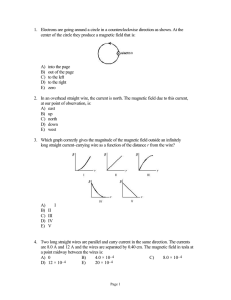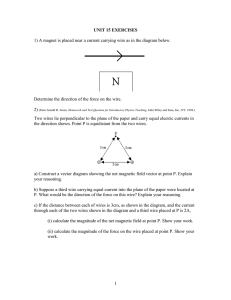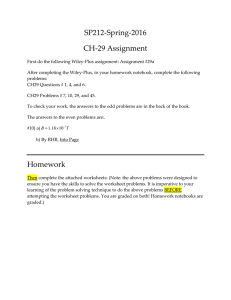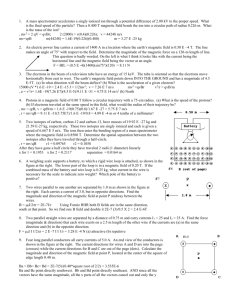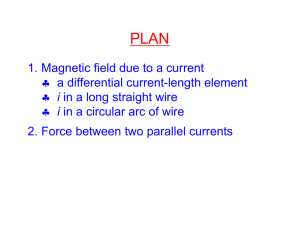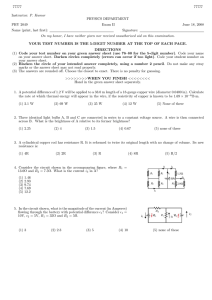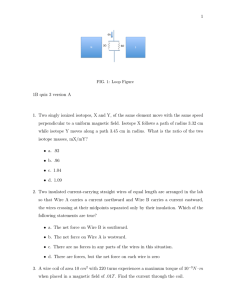Magnetic Fields from Currents Group Worksheet Solution
advertisement
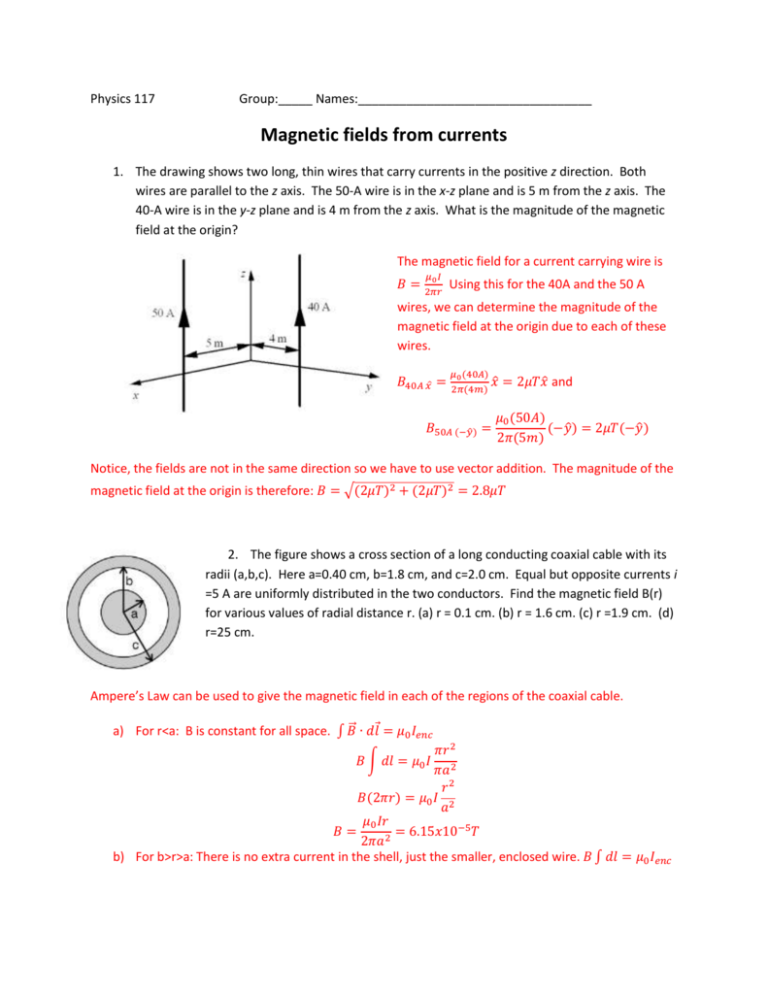
Physics 117 Group:_____ Names:__________________________________ Magnetic fields from currents 1. The drawing shows two long, thin wires that carry currents in the positive z direction. Both wires are parallel to the z axis. The 50-A wire is in the x-z plane and is 5 m from the z axis. The 40-A wire is in the y-z plane and is 4 m from the z axis. What is the magnitude of the magnetic field at the origin? The magnetic field for a current carrying wire is 𝜇 𝐼 0 𝐵 = 2𝜋𝑟 Using this for the 40A and the 50 A wires, we can determine the magnitude of the magnetic field at the origin due to each of these wires. 𝐵40𝐴 𝑥̂ = 𝜇0 (40𝐴) 𝑥̂ 2𝜋(4𝑚) 𝐵50𝐴 (−𝑦̂) = = 2𝜇𝑇𝑥̂ and 𝜇0 (50𝐴) (−𝑦̂) = 2𝜇𝑇(−𝑦̂) 2𝜋(5𝑚) Notice, the fields are not in the same direction so we have to use vector addition. The magnitude of the magnetic field at the origin is therefore: 𝐵 = √(2𝜇𝑇)2 + (2𝜇𝑇)2 = 2.8𝜇𝑇 2. The figure shows a cross section of a long conducting coaxial cable with its radii (a,b,c). Here a=0.40 cm, b=1.8 cm, and c=2.0 cm. Equal but opposite currents i =5 A are uniformly distributed in the two conductors. Find the magnetic field B(r) for various values of radial distance r. (a) r = 0.1 cm. (b) r = 1.6 cm. (c) r =1.9 cm. (d) r=25 cm. Ampere’s Law can be used to give the magnetic field in each of the regions of the coaxial cable. ⃗ ∙ 𝑑𝑙 = 𝜇0 𝐼𝑒𝑛𝑐 a) For r<a: B is constant for all space. ∫ 𝐵 𝜋𝑟 2 𝜋𝑎2 𝑟2 𝐵(2𝜋𝑟) = 𝜇0 𝐼 2 𝑎 𝜇0 𝐼𝑟 𝐵= = 6.15𝑥10−5 𝑇 2𝜋𝑎2 b) For b>r>a: There is no extra current in the shell, just the smaller, enclosed wire. 𝐵 ∫ 𝑑𝑙 = 𝜇0 𝐼𝑒𝑛𝑐 𝐵 ∫ 𝑑𝑙 = 𝜇0 𝐼 𝐵(2𝜋𝑟) = 𝜇0 𝐼 𝜇0 𝐼 = 6.25𝑥10−5 𝑇 2𝜋𝑟 c) For the region b<r<c: The magnetic field from the inner wire will, by superposition, subtract some of the magnetic field from the outer conductor (because the current is in opposite 𝐵= 𝜋𝑟 2 −𝜋𝑏2 directions). So, the ratio of the current density is:𝜋𝑐 2 −𝜋𝑏2 𝐵= 𝐵= 𝜇0 𝐼 𝜇0 𝐼 𝑟 2 − 𝑏 2 − ( ) 2𝜋𝑟 2𝜋𝑟 𝑐 2 − 𝑏 2 𝜇0 𝐼 𝑟2 − 𝑏2 (1 − 2 ) = 2.7𝑥10−5 𝑇 2𝜋𝑟 𝑐 − 𝑏2 d) For the region r>c: The current enclosed is zero so the B field is 0. B=0. 3. Each of the following configurations has a square with side r and current I, in each wire. What is the B field in the center of each square? The B field from a wire is always 𝐵 = 𝜇0 𝐼 , 2𝜋𝑟 so what we have to do here, with the constant r’s (from corner to center) is to consider directions. Situation 1: Here the B fields from the upper left and the lower right will cancel and the B fields from the lower left and the upper right will cancel. So B=0 Situation 2: In this case, the B fields all have components that will add together. 𝑑 = 𝑟√2 2 and then there’s a cosine or sine factor but each corner is at 45 degrees, so we have the same √2⁄2 𝜇 𝐼 √2 ) 2 0 factor for each term. The end result is that 𝐵 = 4 ( 𝑟√2 2 Situation 3: Again, the corners will cancel, so B=0 = 4𝜇0 𝐼 𝑟


